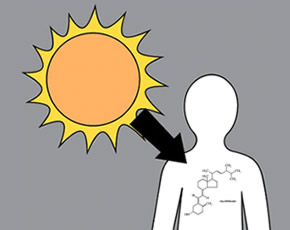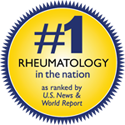
Vitamin D plays an important role in both bone and cartilage homeostasis; however, it is unclear what role vitamin D deficiency and sufficiency play in human osteoarthritis progression. Here, Ding et al (Arthritis Rheum 2009; 60(5): 1381) explore the associations of serum vitamin D and self-reported sunlight exposure with longitudinal changes in knee cartilage volume assessed with magnetic resonance imaging (MRI).
Methods
Community dwelling adults aged 50 – 80 years without rheumatoid arthritis or contraindication to MRI from southern Tasmania (Australia) were randomly selected and enrolled. Participants underwent serum vitamin D assessment, self-report of sunlight exposure, and assessment of knee pain and structure (using plain radiographs and MRI) at baseline and follow-up.
Results
A total of 880 participants underwent baseline MRI scanning. Of these, 748 completed the study and 353 had repeat MRI scans. Participants with low baseline 25-hydroxy vitamin D levels (< 50 nmoles/liter—the equivalent of 20 ng/mL) were more likely to be female, had a slightly higher mean body mass index, and reported lower mean winter and summer sunlight exposures compared to participants with higher vitamin D levels. Those with low vitamin D levels also had lower baseline cartilage volume and bone area at the medial and lateral tibia on MRI; however, radiographic evidence of osteoarthritis did not differ between the groups based on vitamin D status.
In multivariate analyses, both sunlight exposure and 25-hydroxy vitamin D level were significantly associated with baseline knee cartilage volume, after adjusting for demographics, body mass index, season, and comorbid disease. Baseline and change in 25-hydroxy vitamin D levels were also associated with change in cartilage volume of the medial, but not lateral, knee. These associations were not significantly different in analyses stratified by gender, the presence of radiographic OA, or the presence of knee pain. In the fully adjusted model, each tertile increase in vitamin D levels was associated with a +0.9% difference in change in knee cartilage volume (p<0.05).
Conclusions
Both sunlight exposure and vitamin D levels were associated lower knee cartilage volume loss, suggesting that maintaining a robust vitamin D level may help to prevent the progression to osteoarthritis.
Editorial Comment
These findings are compelling, particularly as the association between vitamin D level and less sensitive measures of osteoarthritis (i.e. radiographs) has not been strongly demonstrated in the prior literature. Although there are many reasons to supplement vitamin D to a healthy level in almost everyone, it remains unclear from these data whether supplementing vitamin D in deficient individuals would slow progression to osteoarthritis. Because there are many health behaviors that may confound the observed association between knee cartilage volume and vitamin D status (i.e. other related dietary and lifestyle habits), an interventional trial would be required to determine whether vitamin D supplementation should be a routine part of osteoarthritis preventive care.

